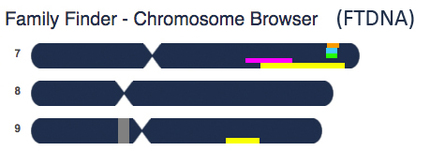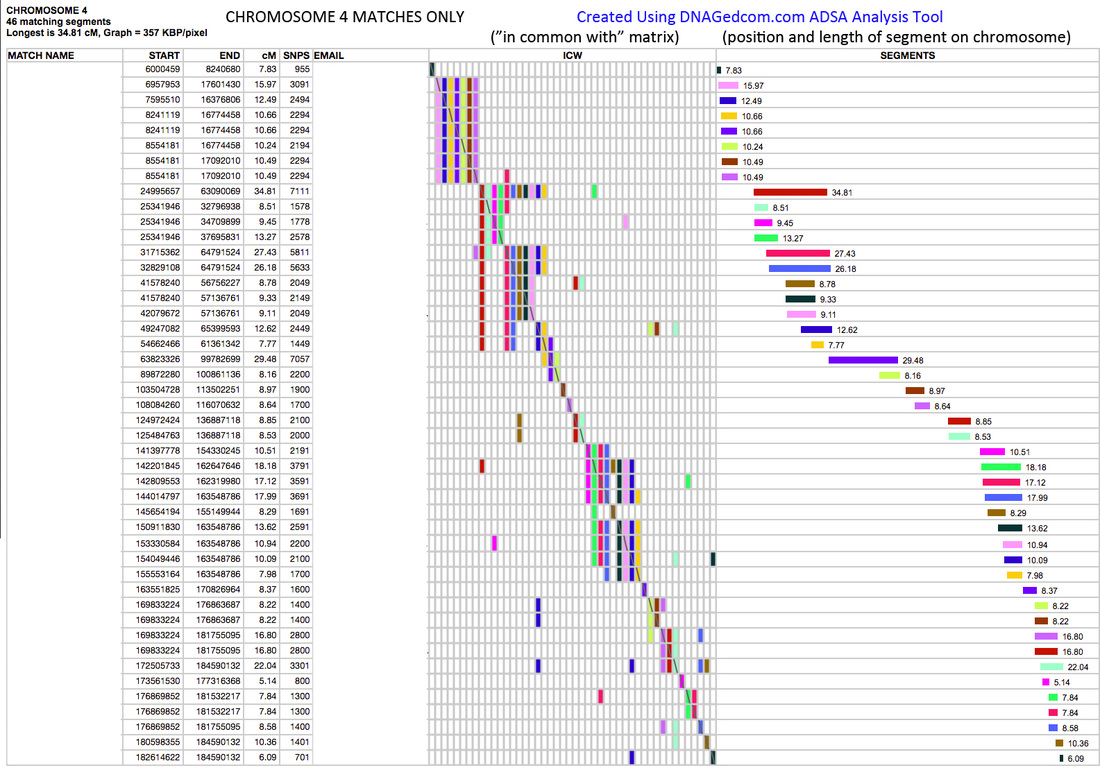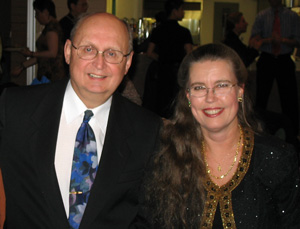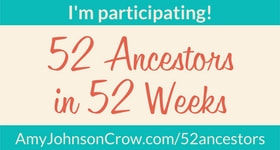In my last blog post I talked about the different types of DNA tests and the reasons why I chose to test my autosomal (family finder) DNA through FamilyTree DNA (FTDNA). I want to find new cousins, and validate what I have already found through traditional research. The results of this DNA test include a list people who share a varying amount of DNA with you on one or more chromosomes, their contact information, and an estimate of how closely you are related. The autosomal DNA tests identify matches from both your father and mother’s side, but they’re all mixed together. It’s up to you to use your traditional genealogy research and other DNA successes to figure out which line and which common ancestors you share.
Generally speaking, the more segments and the bigger the segments, the closer you are related to any given match. The further back you go, the more possible ancestors there are to check or find. There are tools provided so you can see which chromosomes are involved, and tools that allow you to identify subgroups that are “in common with” each other. Here’s just one small example clipped from the Chromosome Browser tool at Family Tree DNA.
 Five of my DNA matches on chromosome 7
Five of my DNA matches on chromosome 7 See the bottom of this posting for an example of another type of chart, created using a powerful analytical tool on the third-party site dnagedcom.com - it's free to use if you already have your autosomal DNA data from other providers such as Family Tree DNA and are willing to upload it to another site. These reports will help you focus you research, one chromosome and group of common matches at a time, contacting these matches in the hopes of finding common surnames and common ancestors.
One of the biggest hurdles is that many people do not yet know who all their direct line ancestors are back 5 or 6 generations. They have gaps in their pedigree charts (as do I) where the common ancestors could be “hiding”. Another problem is that only a small percentage of people have had their DNA tested - it’s a relatively new technology. And if they haven’t tested, you can’t find them as a match. And even if they’ve tested, quite a few don’t answer your emails. It can get discouraging. It makes me very grateful for those who do reply.
None of my more immediate family has had their DNA tested yet. I now understand the benefits of knowing the DNA results for close relatives: it is much easier to determine which common segments on each chromosome came from which line or ancestor. For example, you might identify large segments on chromosomes 4, 9 and 11 (for instance) that is inherited from your mother, and other segments on specific chromosomes from your father's mother, etc.. By “mapping” our chromosomes in this fashion, we can then use this knowledge to zero in on the appropriate line and common ancestors for more distant DNA cousins.
I hereby encourage my close relatives to take a Family Finder DNA test:)
- Downloaded my match data into Excel for analysis, then sorted by name and also by chromosome and segment start position, saving several versions of the sorted spreadsheet for quicker access.
- Downloaded my raw data and uploaded it to the free gedmatch.com (available to 23andMe and Ancestry customers as well as FTDNA) to increase the number of matches available and access their powerful analysis tools.
- Uploaded my result to another analysis site at DNAGedcom.com which makes it easier to understand my match information.
- Joined an email group for “Newbie DNA” folks (I’m now getting inundated with emails!)
- Done a lot of reading to learn more about the theory, matching process, idiosyncrasies and limitations.
- Done more traditional research on my father’s tree to find more ancestors and increase my chances of finding more common ancestors.
- Sent emails to 54 of my matches. 22 of these have not bothered to reply (not a very encouraging ratio) but I'm enjoying continuing conversations with some of the others.
- Found how I connect to 7 of my matches :
- 1 3rd cousin once removed (3C1R) on my mother’s side who I knew prior to DNA testing (as reported in my last posting: "My DNA Adventure Begins");
- 6 new cousins on my father’s side.
- 1 3rd cousin once removed (3C1R) on my mother’s side who I knew prior to DNA testing (as reported in my last posting: "My DNA Adventure Begins");
I also have a new 4th cousin Marla who connects through may paternal HUNT and ALLEN ancestors. We share a DNA segment on chromosome 3. I have two new 5th cousins, both connected through the OSBURN and LEMASTER line: one match involves chromosome 2 and the other chromosome 11.
The final two cousins are further back than expected in my HARPER line - they’re my 6th cousins once removed (6C1R) and share DNA on chromosome 4. This is about as far back as you can reliably go with this autosomal DNA testing. So I’m celebrating!
I have also been very fortunate to have met up with Donna, a very knowledgeable woman who happens to administer the DNA account for one of my matches, even though she is not related to either of us. She has graciously shared some of her experiences, tips and links with me, and helped me identify the common ancestors with a new distant cousin. This particular connection happened to be a couple of generations further back than expected, which (I am told) can be the case when there are intermarriages in the direct lines. As I do not yet know where and when these potential intermarriages occurred, there is still plenty to investigate in this line.
Location also plays a key role in uncovering common ancestors. At the right time, ancestors from both matches must have been in the same location. The main reason that all 6 of my new DNA cousins are on my father’s side is because all his known ancestors lived in the USA, whereas most of my mother’s ancestors lived in England or Canada. It seems that most of the people who have had their DNA tested through FTDNA (and who are also matches with me) also have ancestors in the USA. So the supply of matches is heavily weighted in favor of my paternal ancestors. My father’s ancestors tended to follow the frontier west where historical records are more scarce. Learning more about the history of migration and settlement through land and military records as well as local histories can sometimes bear fruit. But I too still have some persistent gaps in my tree which can be clearly seen in my father's HENSON pedigree chart.
Although DNA research cannot find all your relatives, it is indeed a powerful new and evolving tool to enhance and assist your traditional research methods. I'm only getting started!
What are your experiences with DNA research?
DNA Explained - http://dna-explained.com/
Autosomal Results Basics: http://dna-explained.com/2012/08/19/autosomal-results-the-basics/
DNA Tutorials - http://www.dnaexplain.com/Publications/Publications.asp
Beginners Guide to Genetic Genealogy (with links to tutorials) - https://sites.google.com/site/wheatonsurname/beginners-guide-to-genetic-genealogy
Face it: DNA cannot find all your relatives -
https://medium.com/@dl1dl1/face-it-dna-cannot-find-all-your-relatives-f68089b8e1e9#.v13l8jhsq
Chromosome Basics Video - http://learn.genetics.utah.edu/content/chromosomes/
Segment-ology - http://segmentology.org/
Additional tools if you already have your test results:
GEDmatch Tools for DNA and Genealogical Research (free) - https://www.gedmatch.com
GEDmatch Basics Video - https://www.youtube.com/watch?v=acGJmLlsWg4&feature=youtu.be
DNAgedcom Tools (free) - http://www.dnagedcom.com/
Their "Autosomal DNA Segment Analyzer" Tool (ADSA) is extremely powerful - it can create a single chart for each chromosome that lists all your matches, details of the segment shared, and a grid of who shares relatives with each other ("in common with" matrix). Everything you need shown in one place. In the following example from my matches I have blocked out my match names and email addresses for privacy reasons (click to enlarge further):



 RSS Feed
RSS Feed
